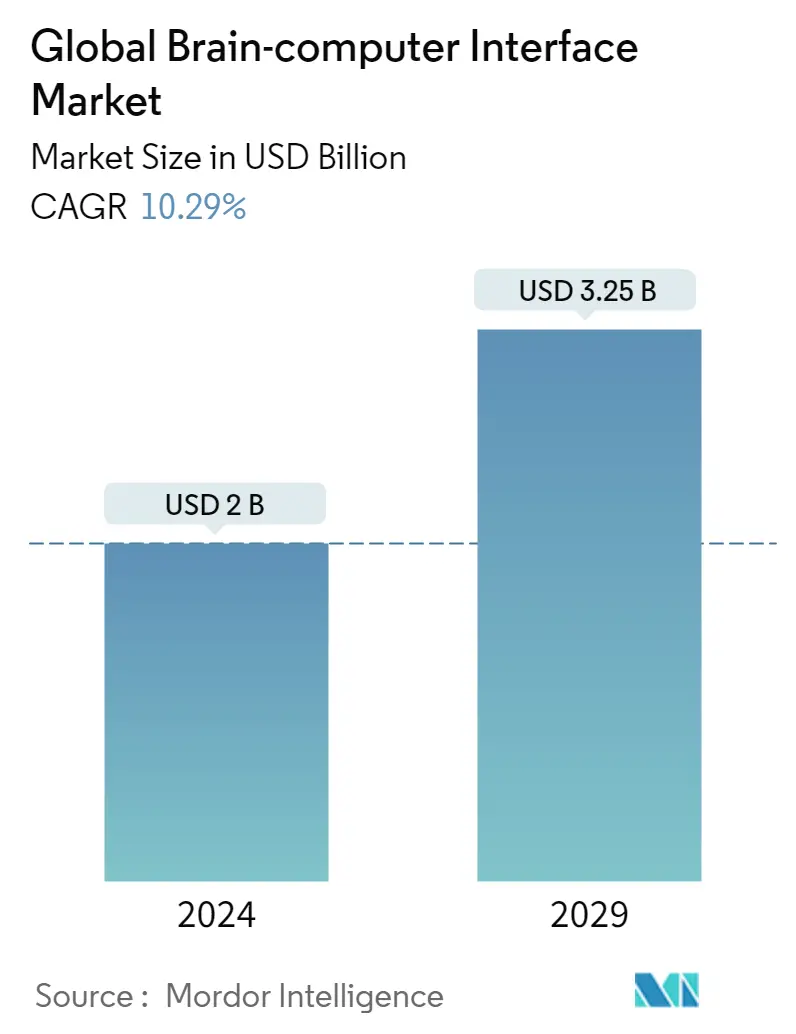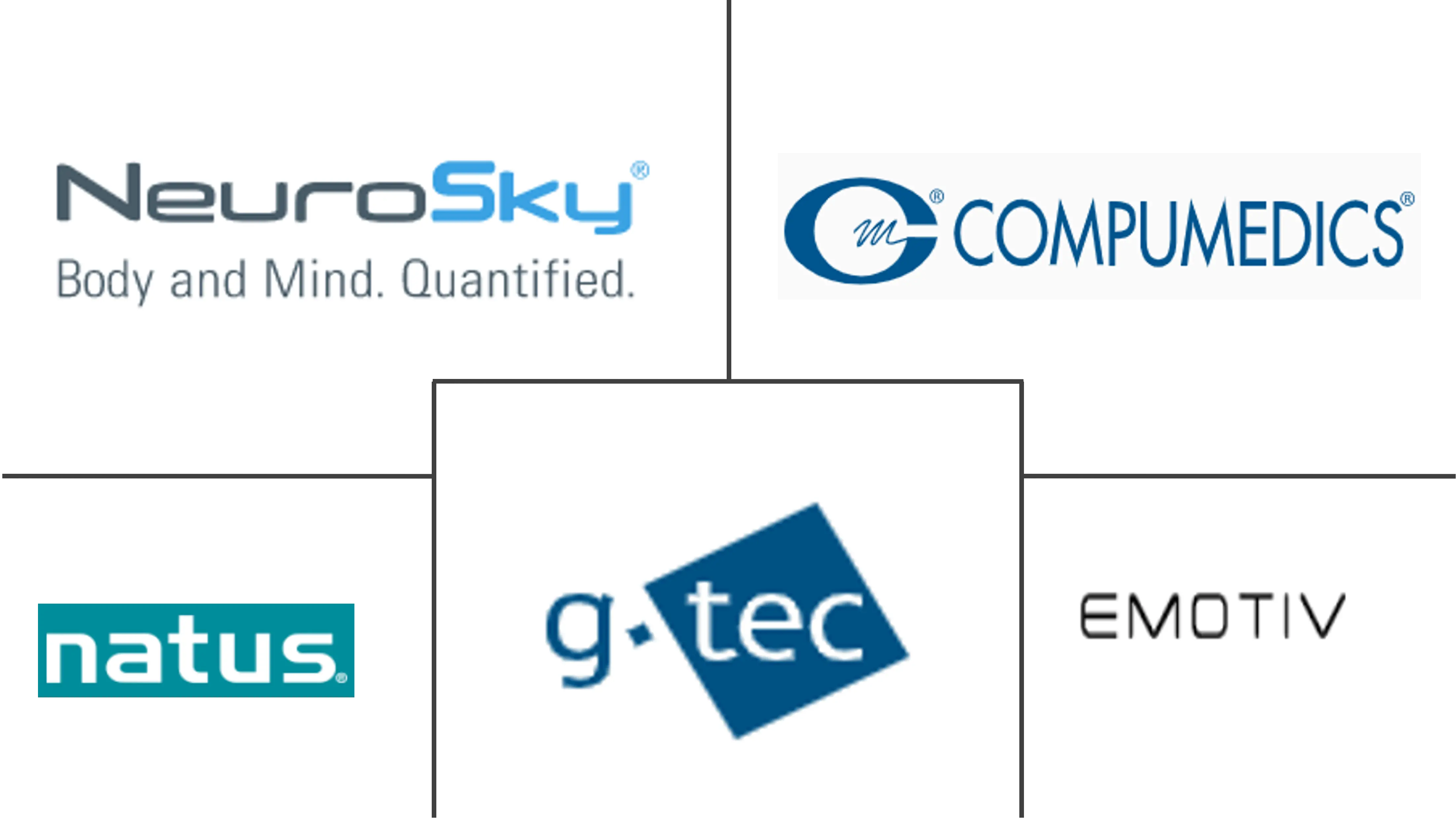Market Size of Global Brain-computer Interface Industry

| Study Period | 2019 - 2029 |
| Market Size (2024) | USD 2.00 Billion |
| Market Size (2029) | USD 3.25 Billion |
| CAGR (2024 - 2029) | 10.29 % |
| Fastest Growing Market | Asia Pacific |
| Largest Market | North America |
Major Players
*Disclaimer: Major Players sorted in no particular order |
Brain-Computer Interface Market Analysis
The Global Brain-computer Interface Market size is estimated at USD 2 billion in 2024, and is expected to reach USD 3.25 billion by 2029, growing at a CAGR of 10.29% during the forecast period (2024-2029).
The initial impact of COVID-19 on the market was significant owing to lockdowns and disruptions in manufacturing and supply chain activities. However, the COVID-19 pandemic has hastened the deployment of new technologies while also increasing end users' reliance on them. The rising usage of brain-computer interface (BCI) technology for the treatment of many elderly patients suffering from physical impairments to translate specific signal features that reflect the elderly's intent into commands and enable them to improve their motor and cognitive abilities, which can be used as a promising tool in rehabilitation medicine during COVID-19, is likely to have a positive impact on the market growth. According to the report "Motor-Imagery EEG-Based BCIs in Wheelchair Movement and Control: A Systematic Literature Review" published in September 2021, the COVID-19 has created an opportunity for the development and implementation of innovative devices like BCIs, biomedical solutions, and assistive technologies (AT) to facilitate people with severe disabilities regarding their participation in daily life.
Further, the brain-computer interface market is likely to show rapid growth due to the increasing prevalence of neurodegenerative disorders, rising R&D activities by the companies to improve the brain-computer interface technology and various technological advancements such as miniaturization of devices.
Among all the factors, the increasing prevalence of neurodegenerative disorders is the foremost factor expected to drive the brain-computer interface market over the forecast period. According to the Parkinson's Foundation, more than 930,000 people in the United States were likely to be suffering from Parkinson's disease in 2020. Moreover, the report by the foundation also predicted that the number of people with Parkinson's disease is expected to rise to 1.2 million by 2030. This represents a projected increase of about 1.8 times in Parkinson's prevalence since 2010, highlighting the need for optimized care and treatment strategies for this patient population to diminish the burden of care on caregivers and ease the economic burden on the healthcare system. Therefore, most of these patients eventually require continuous care and monitoring or help, which can be facilitated by the use of brain-computer interface devices.
Moreover, the increase in R&D activities by various companies and investments from the governments in brain-computer interface technology development and new applications is a chief factor that may promote the growth of the market during the forecast period. For instance, according to an article titled "Funding for Brain-Computer Interface Ventures" published in August 2020, the Australian Federal Government awarded a USD 42 million grant to a research consortium called Bionic Vision Australia to develop bionic vision technology, a type of brain-computer interface technology. The technology was later transferred to Bionic Vision Technologies, which raised USD 18 million from private funders, presumably for further clinical trials and further development. Such investments by governments supporting technological innovation are increasing across the world, which will drive the market's growth globally.
However, the high cost of brain-computer interface devices and a lack of expertise in implementing the systems are the major factors hindering the market's growth.
Brain-Computer Interface Industry Segmentation
As per the scope of the report, a brain-computer interface is a system that facilitates a direct communication pathway between a functional brain and peripheral electronic devices that are used to calibrate the movement in physically challenged individuals. A brain-computer interface system records the brain signal from the surface of the cortex through signaling devices implanted within the brain or from the sensors placed over the scalp. These signals are then transmitted to the connected peripheral device that enables the operator to perform numerous tasks. The brain-computer interface market is segmented by type (invasive brain-computer interface, non-invasive brain-computer interface, and other types), application (restoration of disabilities, repair of brain function, and other applications), and geography (North America, Europe, Asia-Pacific, Middle-East and Africa, and South America). The market report also covers the estimated market sizes and trends for 17 different countries across major regions globally. The report offers the value (in USD million) for the above segments.
| By Type | |
| Invasive Brain-computer Interface | |
| Non-invasive Brain-computer Interface | |
| Other Types |
| By Application | |
| Restoration of Disabilities | |
| Repair of Brain Function | |
| Other Applications |
| By Geography | ||||||||
| ||||||||
| ||||||||
| ||||||||
| ||||||||
|
Global Brain-computer Interface Market Size Summary
The brain-computer interface (BCI) market is poised for substantial growth over the forecast period, driven by advancements in technology and increasing applications in healthcare. The market's expansion is largely attributed to the rising prevalence of neurodegenerative disorders, which necessitate innovative care solutions. The COVID-19 pandemic has further accelerated the adoption of BCI technologies, as they offer promising rehabilitation tools for elderly patients with physical impairments. The market is also witnessing significant investments in research and development, with governments and private entities funding projects to enhance BCI technologies and their applications. This influx of investment is expected to foster technological advancements, such as the miniaturization of devices, which will contribute to the market's growth.
The non-invasive BCI segment is anticipated to dominate the market due to its high applicability and the increasing incidence of neurological disorders. The development of non-invasive devices, particularly those based on electroencephalography (EEG), is expected to enhance the accessibility of BCI technology. Regulatory approvals, such as those from the United States Food and Drug Administration, are further supporting market growth by facilitating the introduction of new devices. The Asia-Pacific region, especially countries like Japan and China, is expected to experience significant market growth, driven by technological advancements and research initiatives. The competitive landscape of the BCI market is characterized by the presence of both international and regional players, with major companies investing in new technologies to maintain their market position.
Global Brain-computer Interface Market Size - Table of Contents
-
1. MARKET DYNAMICS
-
1.1 Market Overview
-
1.2 Market Drivers
-
1.2.1 Increasing Prevalence of Neurodegenerative Disorders
-
1.2.2 Rising R&D Activities by Government to Improve the Brain-computer Interface Technology
-
1.2.3 Various Technological Advancements such as Miniaturization of Devices
-
-
1.3 Market Restraints
-
1.3.1 High Cost of Brain-computer Interface Devices
-
1.3.2 Lack of Expertise in Implementing the Systems
-
-
1.4 Porter's Five Forces Analysis
-
1.4.1 Threat of New Entrants
-
1.4.2 Bargaining Power of Buyers/Consumers
-
1.4.3 Bargaining Power of Suppliers
-
1.4.4 Threat of Substitute Products
-
1.4.5 Intensity of Competitive Rivalry
-
-
-
2. MARKET SEGMENTATION (Market Size by Value - USD million)
-
2.1 By Type
-
2.1.1 Invasive Brain-computer Interface
-
2.1.2 Non-invasive Brain-computer Interface
-
2.1.3 Other Types
-
-
2.2 By Application
-
2.2.1 Restoration of Disabilities
-
2.2.2 Repair of Brain Function
-
2.2.3 Other Applications
-
-
2.3 By Geography
-
2.3.1 North America
-
2.3.1.1 United States
-
2.3.1.2 Canada
-
2.3.1.3 Mexico
-
-
2.3.2 Europe
-
2.3.2.1 Germany
-
2.3.2.2 United Kingdom
-
2.3.2.3 France
-
2.3.2.4 Italy
-
2.3.2.5 Spain
-
2.3.2.6 Rest of Europe
-
-
2.3.3 Asia-Pacific
-
2.3.3.1 China
-
2.3.3.2 Japan
-
2.3.3.3 India
-
2.3.3.4 Australia
-
2.3.3.5 South Korea
-
2.3.3.6 Rest of Asia-Pacific
-
-
2.3.4 Middle-East and Africa
-
2.3.4.1 GCC
-
2.3.4.2 South Africa
-
2.3.4.3 Rest of Middle-East and Africa
-
-
2.3.5 South America
-
2.3.5.1 Brazil
-
2.3.5.2 Argentina
-
2.3.5.3 Rest of South America
-
-
-
Global Brain-computer Interface Market Size FAQs
How big is the Global Brain-computer Interface Market?
The Global Brain-computer Interface Market size is expected to reach USD 2.00 billion in 2024 and grow at a CAGR of 10.29% to reach USD 3.25 billion by 2029.
What is the current Global Brain-computer Interface Market size?
In 2024, the Global Brain-computer Interface Market size is expected to reach USD 2.00 billion.

